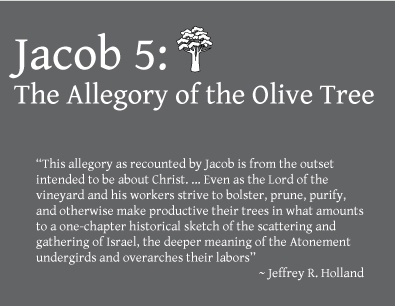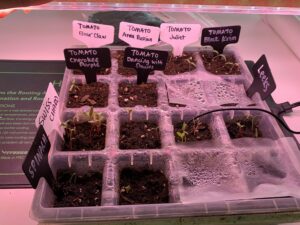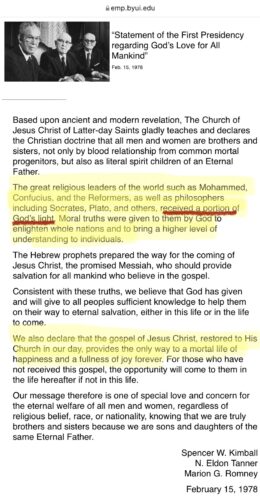I did Jacob 5 differently than the manual. The manual is set up for students who have not read Jacob 5, but as you know, the kids in my class read the text and so “discovery” type activities just don’t work for them. How horrible would it be for me to ask kids to slog through Jacob 5 and then make them reread it again in class???
So anyway, I took the two days for Jacob 5 and changed it into a two part lesson with day one focusing on helping kids understand what they would read, and day two hearing their observations on what they read. It took some finessing of my Seminary lesson chart to make this happen over a weekend, but I’m so glad I did it.
For Day One,
I explained to the class that Jacob 5 is written to answer Jacob’s question at the end of Jacob 4 about how it’s possible that God will redeem his people after they’ve rejected Christ. I explained a little about the premise of the chapter, and I gave them a Jacob 5: Allegory of the Olive Tree study guide I made to help make reading easier. THe study guide contains information on olive production, who Zenos is, the symbolism in the chapter, and a summary of events. It also contains a list of assignments. I really liked the one from the manual about substituting your name in for tree in order to personalize the chapter.
Next We watched a bit of the Greek olive tree grafting videos and discussed how understanding the process of grafting helps us us understand the symbols in the allegory. This video is particularly good because in order to replenish the tree and graft he cuts it down to a nub. Then one of the grafts doesn’t take. He’s very fussy and gentle with the tree, selecting the best place for the grafts and sealing them against the weather. It’s totally the perfect example for this class. The Greek guy has also posted an “after grafting” video that shows what the trees look like after a few days, months, and years. If you use it, be sure to turn on the closed captioning so you can understand what is happening. It took around 20-25 minutes to get to this point.
For the last part of class I used an idea from the Facebook group, and I had the kids make olive trees out of play dough to represent the four visits of the master of the vineyard. I had students make two trees to represent the first visit of the Lord, one wild and one tame, and then graft branches around. Second visit: one tree that was a mixture of good and bad branches. Third visit: APOSTATE OLIVE TREES. This was hilarious. Fourth Visit: kids at each table joined their playdough into a single gigantic Millennial peace tree. As they worked, I explained some of the symbols and what they represent.
Because our class is large and PlayDoh is expensive, I made no cook homemade playdough using this video:
No Cook Homemade PlayDough Recipe:
1 cup water
16-30 drops food coloring
2 T canola/vegetable oil
1.5 c salt
4 c flour
Mix dry ingredients in one bowl. In another bowl, mix wet ingredients. Combine until it pulls together in a dough, and knead it with your hands until you can roll a worm shape and it doesn’t crumble in the center. If your dough is a bit dry, use a spray bottle to spritz the dough and knead it again.
The playdough this makes is of a surprisingly good texture.
This is enough playdough for probably 6-8 kids. A word to the wise: don’t double the recipe. It’s MUCH easier to make batches of this size. Trust me.
For Day Two,
I asked the kids to share a verse that they liked where they had substituted their names in for the trees. I shared verse 74, where I had plugged in parents (tree), children (fruit), our home county (vineyard), and obedience (natural fruit). This went okay. I had forgotten to make the kids take their study guides home on Friday, and so most left them in their cubbies, and I think they forgot the assignment. I did post it in our class Facebook group along with the study guide, but you know how that goes.
Anyway, I showed the Olive Tree Allegory video segments from the Church BoM DVD and we had a little bit of discussion. The video wasn’t terrible, but you do have to explain the clothing changes. I think the DVD was better than the online segments. The students wanted to watch the Olive Tree song, so I let them.
This lesson could have gone better if I had written a clear objective staement. That objective should have been about kids coming to know that Christ will seek to redeem them even if they reject him and Christ works diligently to save all his children.
I wrapped up class with this: “Tomorrow, Jacob 6-7. There is an anti-Christ. We will act it out.” The kids cheered! LOL



